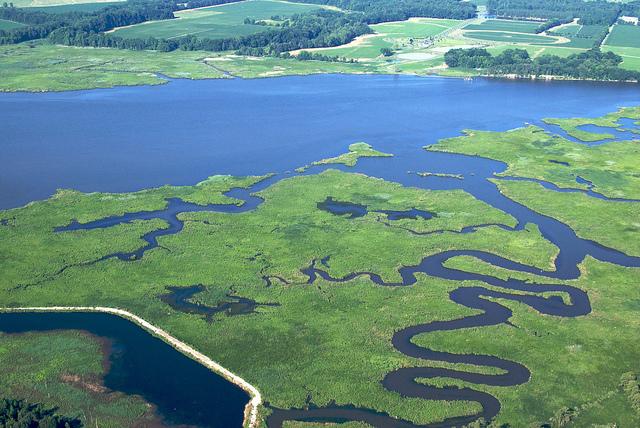
Water quality in the bay has declined in recent decades, largely because of urban storm water and agricultural runoff. Federal and state efforts to clean up the bay have focused on changing land-use to reduce the amount of polluted run-off reaching the bay by, for instance, paying or requiring farmers to plant buffer vegetation to filter pollutants.
Oysters also play an important role in improving water quality in the Chesapeake. As filter feeders, oysters remove pollutants from water as they consume plankton. Historically, oysters were so abundant in the Chesapeake that they posed hazards for navigation. But in the late 19th century, Chesapeake oysters fell victim to a tragedy of the commons. Demand for them was so high that harvesters and states had violent clashes over the resource, during a period now referred to as the “Oyster Wars.” Today, the oyster population is likely below 1% of historic levels.
To restore the oyster population and improve water quality, Maryland and Virginia have expanded permitting for oyster farms. However, like other aspects of the plan to clean up the Chesapeake, oyster farms have generated conflict with competing users of the bay. Although their commercial value and environmental benefits may please harvesters and environmentalists, neighboring property owners may consider oyster farms an eyesore. Similarly, oyster farm infrastructure may get in the way of recreational fishermen or other water-users.
The problem, [St. Mary’s County Commissioner Mike Hewett] said, is that the cages are showing up in areas that are ideal for recreational activities, like swimming and boating. “You’re taking away something people have been able to do for generations,” Hewitt said. Waterfront homeowners also don’t think DNR gives them enough notice about potential oyster leases. [E&E News]
Property owners and other water users are calling for an 18-month moratorium on oyster landings at county docks to discourage the industry’s continued growth. If the county sides with its local, non-oystering residents, that may set up another conflict with the state Department of Natural Resources, which has exclusive authority to regulate oyster permitting in the bay.
Instead of political conflict, might markets and property rights be the answer? If permits were auctioned to the highest bidder and freely transferable, conflicting demands to the bay could be worked out amicably. Where property owners value their views more highly than oyster farmers value a particular spot, the property owners can outbid them or buy-out their permits (which are good for 20 years).
What’s interesting about this conflict is that producers and environmentalists are on one side and recreational users on the other. In many other resource contexts, the political alliances are very different. For instance, opposition to mining and grazing in the West unites many environmentalists and recreational users against producers.
A market solution to oyster conflicts is slightly more complicated than in other situations because there is an externality to account for. If an oyster farm is bought out, neighbor’s views may improve, but downstream users will lose the water-quality benefits oysters provide. This problem can be overcome by allowing downstream property owners, environmentalists, or governments to subsidize the bids of oyster farm permits in areas where the environmental benefits are significant, which would internalize the externality. That solution has the added benefit of encouraging oyster farms to be sited where they can have the greatest environmental benefits, rather than as the result of a bureaucratic or political process.



